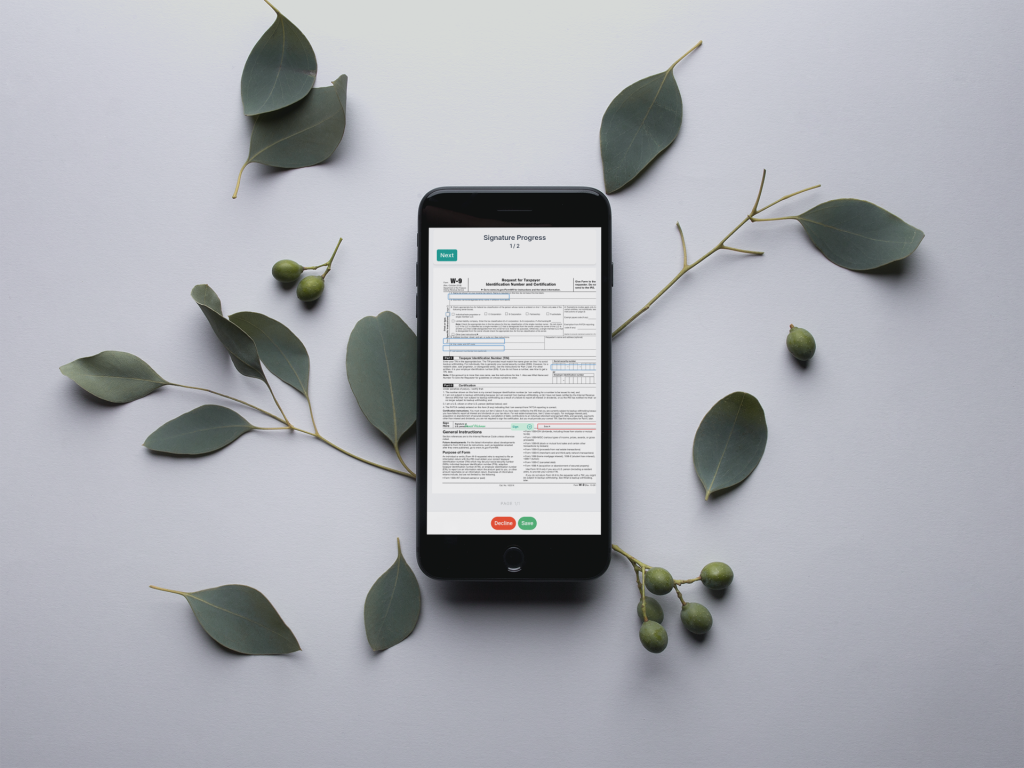The general nature of traditional signatures hasn’t changed for thousands of years.
Signatures serve as the “official stamp” of approval to finalize any process or agreement. And more often than not, a signature is often the last critical piece needed to finalize a legally binding agreement.
“All that’s left to do is meet to have you sign a few forms. Are you free tomorrow?”
“Okay, tomorrow’s no good, how’s Thursday?”
Familiar conversation?
A task that may only take a few minutes is now stretched across days (or even weeks) when an in-person signature is required. Even with the ability to scan and send signed documents, delays occur when someone has to seek access to a functioning printer or scanner. (Not to mention it can be difficult to scan a document with more than few pages.)
Why Electronic Signatures Are Your Solution
Hopefully for you, these kinds of delays are ones of the past thanks to electronic signatures. In more ways than one, electronic signatures have completely transformed the way we work.
A seemingly small tweak in our processes, like the way we sign documents, can be far more powerful than we realize. In other words, singing electronically can save you tons of admin time, and it can save you money. It can also mean less delay on finalizations or contract signing and less room for error. Less effort around these kinds of inefficiencies means more time for the important stuff.
If these kinds of delays are still a part of your day-to-day, you may want to consider making the switch to e-signatures, which we’ll also refer to as “digital signatures”. In fact, it’s likely that most organizations will migrate to e-signatures in the near future (if they haven’t already.)
Either way, it’s important that you understand the nature of e-signatures as they begin to reshape operations across the world.
In the following resource, you’ll find the specifics around e-signatures, how they work, their legitimacy, and why they’re an essential tool for schools, universities, government agencies, and businesses across a variety of industries.
How E-Signatures Work
How exactly do e-signatures work? While there’s an array of different electronic signature software to choose from, they all function somewhat similarly. This isn’t to say that every e-signature platform is necessarily equal, but there are a few universal components supporting the end result.
- The signer will need to create an account. Now, not all electronic signature solutions will have you take this step. But remember that you want to be able to link a person to their signature, so this is one step that helps that to happen.
- The person will agree to sign off on forms electronically.
- The person will need to review a document, and they will be presented with an electronic rendition of a signature. With eSign by Edoc, this can be a pre-determined typeface, or it can be your signature done by mouse or trackpad.
- The person will need to be able to download the “completed” document/have access to that signed document. No matter the solution you choose, you want the person who signed something to be able to have full access to the document they signed.
Although it may differ from program to program, there will be some degree of authentication present to ensure that the signer is who he or she claims to be. This is a big deal for any number of industries—from finance to healthcare to government agencies that need to make sure the person who says they are signing truly IS that person. With eSign by Edoc, our platform provides electronic audit trails, time stamps, and direct email delivery to the signer to verify authenticity.) Beyond these, users have the option to add further verification measures if they choose. Ask us about setting up custom features for your agency or business.)
Although all trusted e-signature platforms might function similarly at a high level to be legally valid, there are certainly favorable features within each software to seek out. It’s best to choose a software that offers multiple authentication routes, custom development and integration, and access to a dedicated customer care team to help you every step of the way.
With these measures intact, businesses can rest assured that the e-signatures they’re utilizing are not only secure, but also legitimate. But what exactly classifies a signature as legal?
What Makes a Legally Binding E-Signature
In 2000, President Bill Clinton signed the E-Sign Act which outlined a number of regulations to ensure the legitimacy of electronic contracts. This act federally protects the legality of any e-signatures being used within interstate and global commerce transactions.
There are five areas around which e-signature providers must verify validity:
- Intent to sign. This, essentially, just affirms that the signer understands what that they are about to sign and verifies that they are aware of their intent to view and sign the document. Just just like it sounds, you want to be sure that the person is who they say they are, and that the person has agreed to digitally sign.
- Signature association with the document. Both the e-signature and the document must be specifically linked. A unique, randomly generated code in the attestation will link the two together with eSign by Edoc, ensuring that the signatures can be associated with the document. Additionally, if needed, users can be provided with an electronic audit trail of all documents signed.
- Use of tamper-proof records. The document must be one that cannot be changed or edited. Upon clicking submit (and signing) in eSign by Edoc, the document will become an unalterable PDF.
- Proper storage and access of documents for all parties. All parties involved in the agreement must have secure access to the signed documents. Ouyr eSign system features a document management platform that allows all parties to download and safely store their documents. We always recommend you download it to your own server or storage, but you do have access to all your files to download once you’ve signed them!
- Court-accessible audit log complete with authentication details. This says that proof of time stamps and identity authentication must be present to ensure legality of the document. The eSign by Edoc platform provides time stamping and verifies identity through email delivery of documents. With our custom development package, the user has the ability to add additional steps for further authentication, too, which can be popular with medical and healthcare applications and any setting where more security is desired.
E-Signature Exceptions in the E-Sign Act
There are a few exceptions in regards to which documents are covered under the E-Sign Act:
- Specific areas of the Uniform Commercial Code
- Wills, codicils, and trusts
- Adoption documents
- Divorce decrees
- Court orders and notices
- Official court documents, including briefs and pleadings
- Notices of the termination of utility services
- Notices of default, foreclosure, repossession, or eviction
- The cancellation of insurance benefits
- Product recalls or notices of material failures
- Documentation accompanying the transportation of hazardous materials
These guidelines encompass the needs for federal legitimacy, while there are still state-specific requirements that businesses must adhere to in order to achieve legitimacy. Although these requirements differ from state to state, the most notable differences occur in home construction and service supplier agreements.
In Ohio, for example, the state requires residential contracts exceeding $25,000 to include a number of additional conditions to be considered valid, as of the time this article was written. That means you want to be sure the forms or paperwork you are getting signed CAN be legally signed via electronic signing.
When You Should Use E-Signatures
The short answer? Almost always. Thanks to the E-Sign Act, it’s completely legal to utilize an electronic signature any time that you need one (well, ALMOST any time!) Unless the signer prefers to record their signature in-person, there’s no reason that an electronic signature wouldn’t suffice.
The longer answer? There are certainly a few fitting scenarios that exist where an e-signature might be a huge benefit for your organization. For example:
When speed and convenience are at the top of your priority list. How many of your processes require the approval of multiple individuals? Likely more than one. It’s not uncommon to see week-long or even month-long delays when multiple physical signatures are needed. E-signatures can dramatically streamline the chain of approval simply by allowing each person to digitally and remotely sign. The great thing about eSign by Edoc is that these digital signatures can also be collected in-person and remotely—or a combination of both.
When you need to save money. There are a number of angles where you’ll cut costs by switching to e-signatures—but generally, by decreasing the inefficiencies around physical signatures, you’ll be able to allocate less of your revenue to them.
More specifically, if you operate in an industry that regularly mails out physical documents, or if you regularly have to drive to certain homes or buildings to gather signatures, you’ll see dramatic cuts to your shipping and/or travel-related costs.
When you need to streamline a complex process. Forms surrounding onboarding, scheduling, and tax-related purposes are typically part of a rather tedious process. E-signatures can simplify these processes for the entire team.
When you want to have peace of mind about the security of your documents. A trusted e-signature software will have built-in compliance, will follow best practices for data security, and it can follow authentication measures that keep your data private and safe. A document with sensitive information is better off in a secure, electronic management platform than it is in a filing cabinet, which is surprising for many people to realize.
When you want to reduce your environmental impact. This one’s pretty simple, even though not all businesses make decisions based on environmental impact alone. Less paper! (1, 2, 3)
Help Support Your Staff with eSign For Your Electronic Signatures
eSign helps you to be more efficient in sending, compiling, and approving all kinds of paperwork and forms. With eSign, your organization can digitize any form and then send it out to individuals for approval—and that’s legally binding and totally secure, from start to finish.
eSig by Edoc gives both staff and the individuals you serve more time to focus on what’s most important. It also allows everyone involved to have instant access to all kinds of paperwork. Request a demo today: Learn more about eSign by Edoc at edocesign.com
Sources:
- https://www.business.com/articles/electronic-signatures-and-the-law-what-you-need-to-know/
- https://www.contractworks.com/blog/the-future-of-electronic-signatures-is-handwritten-identification-dead
- www.edocesign.com

